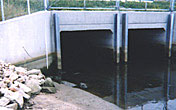| Galilee Salt Marsh |
Virtual Field Trip |
21 22 23 24 25 26 27 28 29 30 home
| Galilee Salt Marsh |
Virtual Field Trip |

"I really want to tell you about the good changes that are beginning to happen here. The larger areas of mud that you see is a result of the dredging that the state did a little while ago. They took tons of material from this spot and placed it where you can see that large, long mound in the background. The tall, reed-like plants growing there are called Phragmites, and they are a sure sign of an unhealthy marsh.""This dredged area looked like that before, but now we have placed small plugs of Spartina patens to help nature along. The seed heads from the healthy side will float in on the tide and reseed itself here in the mud."
"Gee, how is that going to happen if this road is cutting off the tidal flow, Brian?"
"Great question! Turn around and take a look at the culvert behind you."

"That opening was dug under the road to allow the flow of the tides to reach this side and bring back the critters and plants that are naturally found in a salt marsh. It will take a long time, we think, but we are getting a lot of evidence that changes are already happening.""As I take you along for a walk on this side, keep in mind that life is very difficult for wetland plants and animals and you should take care where you step, so as not to disturb them. This is a large restoration project and some of these organisms are extremely fragile. If you see something that you have a question about, don't hesitate to ask me."